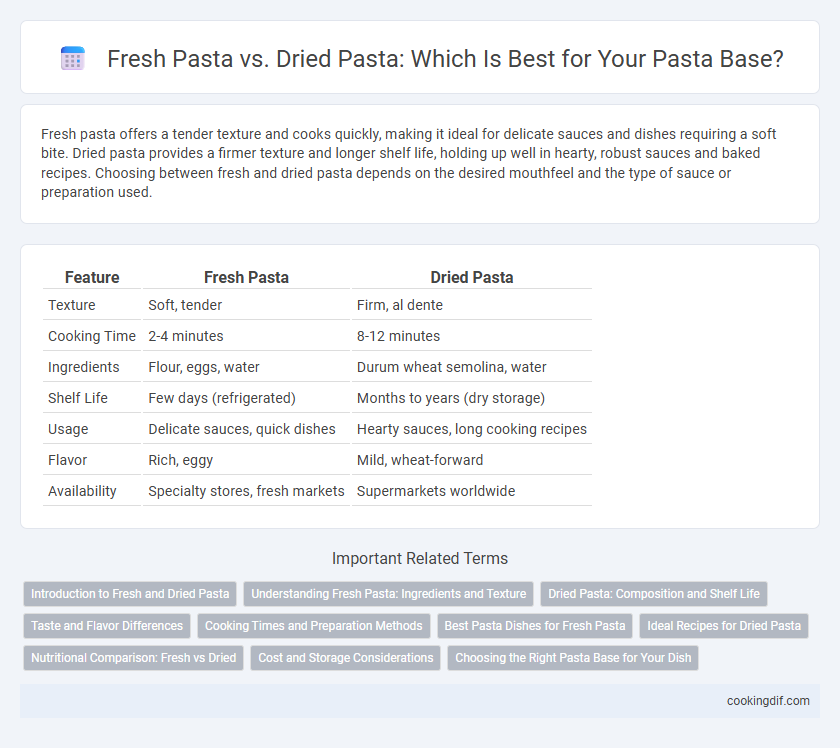Fresh pasta offers a tender texture and cooks quickly, making it ideal for delicate sauces and dishes requiring a soft bite. Dried pasta provides a firmer texture and longer shelf life, holding up well in hearty, robust sauces and baked recipes. Choosing between fresh and dried pasta depends on the desired mouthfeel and the type of sauce or preparation used.
Table of Comparison
| Feature | Fresh Pasta | Dried Pasta |
|---|---|---|
| Texture | Soft, tender | Firm, al dente |
| Cooking Time | 2-4 minutes | 8-12 minutes |
| Ingredients | Flour, eggs, water | Durum wheat semolina, water |
| Shelf Life | Few days (refrigerated) | Months to years (dry storage) |
| Usage | Delicate sauces, quick dishes | Hearty sauces, long cooking recipes |
| Flavor | Rich, eggy | Mild, wheat-forward |
| Availability | Specialty stores, fresh markets | Supermarkets worldwide |
Introduction to Fresh and Dried Pasta
Fresh pasta offers a tender texture and cooks quickly due to its higher moisture content, making it ideal for delicate sauces and quick meals. Dried pasta, made from durum wheat semolina, provides a firmer bite and longer shelf life, suitable for hearty sauces and batch cooking. Understanding these differences helps in selecting the best pasta base for diverse culinary applications.
Understanding Fresh Pasta: Ingredients and Texture
Fresh pasta, made from simple ingredients like eggs, flour, and sometimes water, offers a tender and delicate texture that cooks faster than dried pasta. Its higher moisture content gives it a softer bite and a rich flavor profile that enhances sauces and fillings. Understanding these qualities helps in choosing fresh pasta for dishes requiring a smooth, supple base that absorbs flavors intensively.
Dried Pasta: Composition and Shelf Life
Dried pasta is made from durum wheat semolina mixed with water and then carefully dried to reduce moisture content, which enhances its durability and firmness. Its low moisture level allows it to have an extended shelf life, typically lasting between 1 to 2 years when stored in a cool, dry place away from direct sunlight. This resilience makes dried pasta a convenient pantry staple for long-term storage without compromising on texture when cooked properly.
Taste and Flavor Differences
Fresh pasta offers a delicate texture and richer flavor due to its higher moisture content and use of eggs, which enhances the overall taste experience. Dried pasta has a firmer bite and a more concentrated wheat flavor, making it ideal for robust sauces that cling well to its surface. Both types provide distinct taste profiles that influence the final dish's flavor depth and mouthfeel.
Cooking Times and Preparation Methods
Fresh pasta cooks significantly faster than dried pasta, usually requiring only 2 to 4 minutes in boiling water, compared to 8 to 12 minutes for dried varieties. The preparation of fresh pasta involves rolling and cutting soft dough made from eggs and flour, while dried pasta is made by extruding dough that is then dehydrated for shelf stability. Choosing fresh pasta ensures a tender texture and quick cooking, whereas dried pasta offers longer storage and a firm bite after extended cooking times.
Best Pasta Dishes for Fresh Pasta
Fresh pasta boasts a tender texture and delicate flavor, making it ideal for rich, velvety sauces like Alfredo, carbonara, or sage brown butter, which cling beautifully to its porous surface. Classic dishes such as fettuccine Alfredo, homemade ravioli filled with ricotta and spinach, or pappardelle with slow-cooked ragu highlight fresh pasta's ability to absorb and enhance robust, creamy, and complex sauces. Its quick cooking time and supple consistency offer an exquisite base for dishes where sauce absorption and freshness are paramount to achieving authentic Italian flavors.
Ideal Recipes for Dried Pasta
Dried pasta's firm texture and ability to hold shape make it ideal for hearty sauces like Bolognese, marinara, or creamy Alfredo. Its long shelf life and consistent cooking time suit recipes requiring al dente pasta with robust flavors, such as baked ziti or spaghetti aglio e olio. Recipes emphasizing slow simmered sauces benefit from dried pasta absorbing flavors without becoming mushy.
Nutritional Comparison: Fresh vs Dried
Fresh pasta contains higher moisture content and typically offers more vitamins and minerals due to its less processed nature, including elevated levels of B vitamins and folate. Dried pasta provides a longer shelf life and a higher concentration of carbohydrates and protein per serving, making it a more energy-dense option. Both types of pasta have similar calorie counts, but fresh pasta usually has a lower glycemic index, which can lead to slower blood sugar release.
Cost and Storage Considerations
Fresh pasta typically costs more due to its perishable nature and requires refrigeration or freezing for storage, shortening its shelf life to a few days or weeks. Dried pasta offers a more economical option, with a longer shelf life of up to two years when stored in a cool, dry place, making it ideal for bulk purchases and extended storage. Cost efficiency and ease of storage make dried pasta a preferred choice for home cooks and restaurants managing inventory.
Choosing the Right Pasta Base for Your Dish
Fresh pasta offers a tender texture and cooks quickly, making it ideal for delicate sauces and dishes requiring a smooth, silky base. Dried pasta provides a firmer bite and longer shelf life, perfect for robust sauces like marinara or ragu that benefit from a sturdy pasta structure. Selecting the right pasta base depends on balancing sauce weight, dish preparation time, and desired texture for optimal flavor harmony.
Fresh pasta vs dried pasta for pasta base Infographic

 cookingdif.com
cookingdif.com